Sedna: Inuit Goddess Sacrificed By Selfish Father Fearing For His Own Life
A. Sutherland - AncientPages.com - Unlike American Indians, the Inuit people of Canada and Greenland have not in their cultural legacy many mythological stories from the time before the appearance of humans.
The Inuit people believed in the divinity of the sea and all the animals that dwelled in it. In many myths and legends of Arctic culture, Sedna is the highly honored deity and plays an important role, no matter the versions of her story and the diversity of her names given her by different Inuit groups.
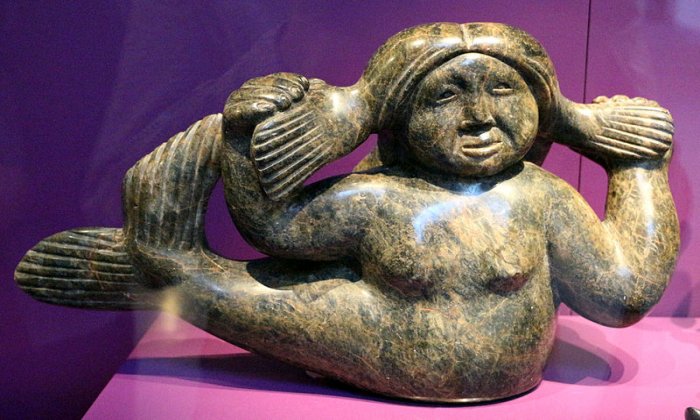 Sculptures in the National Museum of Finland. Image credit: Sailko - CC BY 3.0
Sculptures in the National Museum of Finland. Image credit: Sailko - CC BY 3.0
Her story was widely distributed in many versions across Canada and Greenland.
In Inuit mythology, Sedna is the daughter of two giants who lived a very long time ago at the beginning of the world. She is a great spirit-goddess also known as the Mother of the Sea or Mistress of the Sea, and the progenitor of all sea creatures. She rules over the sea world, controlling all sea mammals.
Her father, Anguta, created the earth, the sea, and the heavens, while Sedna populated the sea with animals, and so she became the most powerful force in Inuit life.
According to one legend, she was a beautiful maiden, that one day was carried off by a raven, which wanted her to be his bride. In another version, the raven is replaced by a handsome mysterious hunter with an outfit made of furs, and his face was mysteriously covered. Sedna’s father explained that the man wanted a wife his daughter would be a good and capable companion, capable of sewing and cooking. The mysterious man accepted and took Sedna in a boat to their new home, which as the man said, was located on a beautiful island full of huts and people. When they arrived she saw nothing except a few stones, a cliff, and loons. From now on her only food would be raw fish.
For the first time, the man exposed his face, and at that moment Sedna realized that he was a raven (in another version, he was a young loon), who could disguise himself whenever he wanted.
“I used my power to transform myself into a human after I fell in love with you,” said the young loon.
“Otherwise, you would not have come away with me.”
Unhappy to live on the island, after a few days, she began to scream and calling her father, hoping her voice would reach him one day. He finally arrived and took Sedna to her true home.
When Sedna’s loon-husband came home, he wanted to know where his wife was. “Her father came and took her away,” the birds cried. He quickly disguised himself as the human, jumped into his kayak to chase Sedna. In the meantime, after several hours on the sea, they spotted a bird flying in the distance, It was the spirit bird and at that moment, Sedna knew that her husband had found her, using another disguise.
Her father tried to drive him away with the oars but the ocean was becoming more violent, and the man failed. The spirit-bird was seeking revenge, and the old man knew he must appease the angry spirit. There was only one way to satisfy the creature – to throw his daughter overboard into the sea.
Once her father had made this horrible sacrifice, Sedna struggled to keep her head above the water as giant waves washed over her. For a moment she was able to grip the gunwales of her father’s kayak but the old man was so frightened that he cut away her half-frozen fingers.
When at last she was able to grip the gunwales of her father’s kayak, he was seized with fear. “I must do it,” he cried, “the spirit-bird makes the sea angry and demands your life.”
Sedna’s body slowly disappeared beneath the icy waters. Her fingertips became the small fishes and seals; her middle joints – the larger sea animals. Finally, her last joints became walruses and whales.
Her grief-stricken father returned home. The old man lay down on a thick pile of caribou hides inside the little tent, which was his and Sedna’s home for many years. During the night, giant waves of another storm reached the little tent where Sedna’s old father was sleeping. When the last powerful wave returned to the sea that night, it took the old man with it, down to Sedna’s home at the bottom of the sea.
Now, they together live at the bottom of the sea, and Sedna is a great spirit-goddess of the sea. She rules over the sea waters and all the animals that live there and is said to control the weather in the sea. Sedna has the power to either provide or destroy, and reigns over a vast realm where human souls, including her father’s, were imprisoned as punishment after death.
Far back in time, in case of impending hunger, the Arctic shamans often traveled across the sea and went into trance to come down to Adlivun, Sedna’s underwater home, and the Inuit underworld, to negotiate with the goddess and plead with her for food for people. Sometimes, Sedna was angry, denied their requests, and sent them back to the surface.
Next time, when she was in a good mood, she promised that hunters would have food for their families during the harsh winter seasons.
Written by – A. Sutherland - AncientPages.com Senior Staff Writer
Copyright © AncientPages.com All rights reserved. This material may not be published, broadcast, rewritten or redistributed in whole or part without the express written permission of AncientPages.com
More From Ancient Pages
-
 Secrets Of Mount Shasta – One Of The Most Sacred Places On Earth
Ancient Mysteries | Oct 24, 2015
Secrets Of Mount Shasta – One Of The Most Sacred Places On Earth
Ancient Mysteries | Oct 24, 2015 -
 Unusual And Well-Preserved Skeleton Discovered In Ancient Pompeii Sheds New Light On The Cultural Life Of The City
Archaeology | Aug 18, 2021
Unusual And Well-Preserved Skeleton Discovered In Ancient Pompeii Sheds New Light On The Cultural Life Of The City
Archaeology | Aug 18, 2021 -
 On This Day In History: Battle Of Lissa Took Place In The Adriatic Sea – On July 20, 1866
News | Jul 20, 2016
On This Day In History: Battle Of Lissa Took Place In The Adriatic Sea – On July 20, 1866
News | Jul 20, 2016 -
 Solutrean People: Were First Americans European Stone Age People?
Civilizations | Feb 23, 2018
Solutrean People: Were First Americans European Stone Age People?
Civilizations | Feb 23, 2018 -
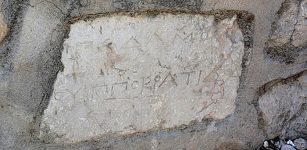 2,300-Year-Old Tablet Found In Mugla, Turkey – Region Of Great Historical Importance In Ancient Times
Archaeology | Jun 5, 2019
2,300-Year-Old Tablet Found In Mugla, Turkey – Region Of Great Historical Importance In Ancient Times
Archaeology | Jun 5, 2019 -
 Future Of Thornborough Henges Secured – Stonehenge Of The North Preserved For The Nation
News | Feb 3, 2023
Future Of Thornborough Henges Secured – Stonehenge Of The North Preserved For The Nation
News | Feb 3, 2023 -
 Ancient Egyptians Knew About ‘Demon Star’ Algol’s Variability 3,000 Years Before Western Astronomers
Archaeology | Nov 13, 2018
Ancient Egyptians Knew About ‘Demon Star’ Algol’s Variability 3,000 Years Before Western Astronomers
Archaeology | Nov 13, 2018 -
 Bronze Age Finding Offer New Clues On The Beginnings Of Cardiff
Archaeology | Jul 15, 2022
Bronze Age Finding Offer New Clues On The Beginnings Of Cardiff
Archaeology | Jul 15, 2022 -
 ‘Spectacular’ New Find: Roman Military Camps In Desert Found By Archaeologists Using Google Earth
Archaeology | Apr 27, 2023
‘Spectacular’ New Find: Roman Military Camps In Desert Found By Archaeologists Using Google Earth
Archaeology | Apr 27, 2023 -
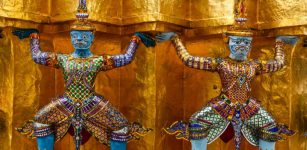 Rakshasas: Night Wandering Race Of Demons And Warriors Fuelled By Kundalini In Hindu Beliefs
Featured Stories | Oct 8, 2019
Rakshasas: Night Wandering Race Of Demons And Warriors Fuelled By Kundalini In Hindu Beliefs
Featured Stories | Oct 8, 2019 -
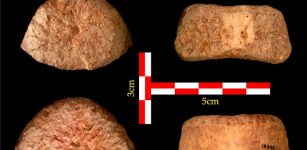 1.5 Million-Year-Old Human Vertebra Discovered In Israel’s Jordan Valley Sheds New Light On Migration From Africa To Eurasia
Archaeology | Feb 3, 2022
1.5 Million-Year-Old Human Vertebra Discovered In Israel’s Jordan Valley Sheds New Light On Migration From Africa To Eurasia
Archaeology | Feb 3, 2022 -
 Archaeological Enigma On The Træna Islands – What Happened To The Local Community?
Archaeology | Nov 28, 2023
Archaeological Enigma On The Træna Islands – What Happened To The Local Community?
Archaeology | Nov 28, 2023 -
 Mysterious Railway Car Discovered Under An Old Fortress In Antwerp, Belgium
Archaeology | Apr 12, 2024
Mysterious Railway Car Discovered Under An Old Fortress In Antwerp, Belgium
Archaeology | Apr 12, 2024 -
 New Fossil Ape Challenges The Story Of Human Evolution
Evolution | Aug 24, 2023
New Fossil Ape Challenges The Story Of Human Evolution
Evolution | Aug 24, 2023 -
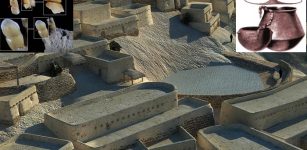 4,000 Years Ago Women Of El Argar Used Their Teeth As Tools
Archaeology | Nov 10, 2020
4,000 Years Ago Women Of El Argar Used Their Teeth As Tools
Archaeology | Nov 10, 2020 -
 Denisovans Were First To Adapt To High Altitude And Harsh Conditions Of Tibetan Plateau
Archaeology | May 2, 2019
Denisovans Were First To Adapt To High Altitude And Harsh Conditions Of Tibetan Plateau
Archaeology | May 2, 2019 -
 Remains Of A 2,300-Year-Old Sunken Ship Discovered At Alamein Shore
Archaeology | Aug 12, 2023
Remains Of A 2,300-Year-Old Sunken Ship Discovered At Alamein Shore
Archaeology | Aug 12, 2023 -
 1,200-Year-Old Wari Temple Discovered In Peru
Archaeology | Feb 24, 2023
1,200-Year-Old Wari Temple Discovered In Peru
Archaeology | Feb 24, 2023 -
 Evidence Hominins Were Present In Europe Far Earlier Than Previously Thought
Human Beginnings | Jan 28, 2025
Evidence Hominins Were Present In Europe Far Earlier Than Previously Thought
Human Beginnings | Jan 28, 2025 -
 On This Day In History: Sunspot Observed By Chinese Astronomers During The Han Dynasty – On May 10, 28 BC
News | May 10, 2016
On This Day In History: Sunspot Observed By Chinese Astronomers During The Han Dynasty – On May 10, 28 BC
News | May 10, 2016
